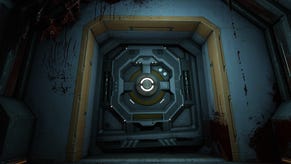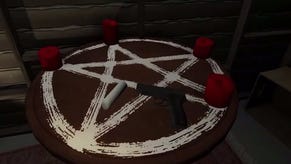Gone Home review
A house is not a home.
Gone Home, an engaging but frustratingly slight narrative game from new Portland indie outfit The Fullbright Company, announces its intentions quite clearly with its title and its setup. It's 1995 and you play Katie, returning to Oregon after a long trip to Europe to find your family's new home empty and an enigmatic note taped to the door. Where is everyone? Exploring the large, unfamiliar house, you search for clues to where your parents and teenage sister Sam might be - and what might have happened to them in the past year that won't fit on the back of a postcard.
This game has a resolutely domestic scale: with a storm raging outside, you're not even permitted to leave the house. The Fullbright Company has decided that family drama, the subject of so much great art, ought to make a suitable subject for a video game - and quite right too. It's a noble aim, and it's executed with some skill, within the curious limitations of the format the studio has chosen. But noble intentions aren't enough in themselves, and when the screen fades to black it turns out that Gone Home doesn't have much to say for itself. It's more manifesto than message.
That it succeeds in holding your attention for a couple of hours is down to some strong writing and effective, if slightly cheap, use of a couple of potent hooks. The first of these is a fine eye for 90s pop culture nostalgia that chimes with the archaeological feel of the gameplay as you rummage through a disordered house that might have been left 20 minutes or 20 years ago. Anyone who was a teen in the period won't be able to resist a misty smile at the home-taped copies of The X Files, the cut-and-pasted riot grrrl 'zines, the mixtapes scrawled in biro, the plaid-filled closets and the gig posters announcing turns by Buffalo Tom, Lisa Loeb and The Mighty Mighty Bosstones. There are even tracks from Heavens to Betsy and Bratmobile on the soundtrack.
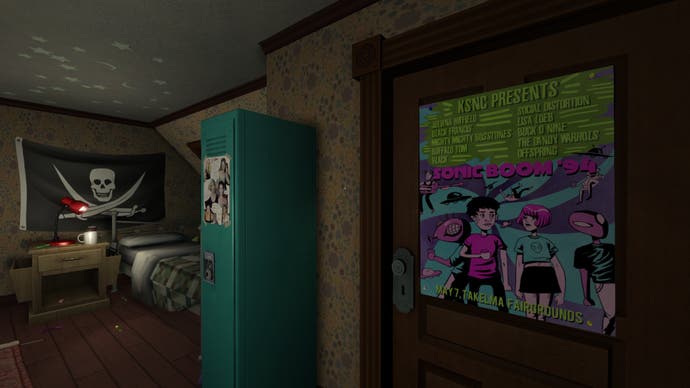
The second hook is more problematic. Although Gone Home is really about piecing together the personal lives of your family members - especially Sam's - it frames itself as a spooky mystery on a dark and stormy night, and employs a few cheesy devices to keep the tension high. The thunder crashes outside and ominous music broods as you pick up dark hints about the building you're in; it was inherited from a strange great-uncle and is called "the psycho house" by Sam's schoolmates. Perhaps it hides a secret?
Well, it does, but it's not really the secret the game's atmosphere is selling. The problem is that the The Fullbright Company doesn't manage (or even attempt, really) to reconcile this creepy grand guignol flavour with the main thrust of the storyline. Unresolved, it's left hanging there, exposed as a crude storytelling tool that cheapens the easy naturalism Gone Home achieves elsewhere. If the game's goals weren't clear from the outset, you could call it dishonest; as it is, it suggests a disappointing lack of confidence in the intimate scale that is Gone Home's whole raison d'être.
It's not as experimental as Dear Esther, Proteus or Thirty Flights of Loving... But while those games innovated by borrowing from prose, installation art and film, Gone Home's techniques are native to video games
Aside from this stumble, Gone Home is a technically assured piece of interactive storytelling that makes for an interesting comparison with the recent spate of first-person art games. It's not as experimental (nor as arguably pretentious) a piece as Dear Esther or Proteus, for example, and it offers nothing as energising as Thirty Flights of Loving's thrilling use of the jump cut. But while those games innovated by borrowing liberally from the toolboxes of prose, installation art and film, Gone Home's techniques are native to video games.
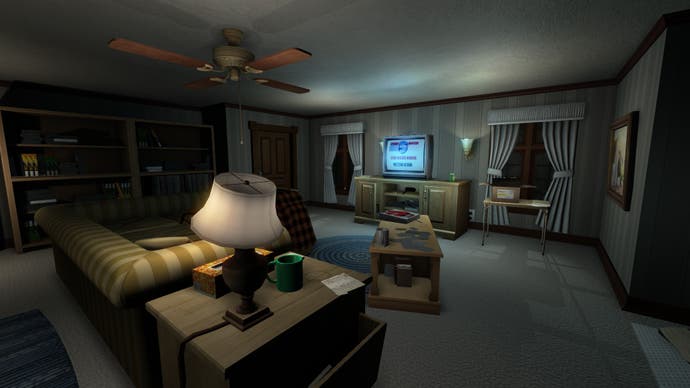
The Fullbright Company's Steve Gaynor, Karla Zimonja and Johnnemann Nordhagen worked together on the BioShock series, notably the acclaimed add-on for BioShock 2, Minerva's Den. Gone Home works in a very similar idiom to BioShock, telling its story of a fractured family through text fragments and audio clips as well as a steady build-up of set-dressing detail. You move through the house, opening drawers and examining objects, reading letters and notes, following a course dictated by a breadcrumb trail of locks and hidden keys. It is essentially a whole experience built from the tools first-person games like BioShock, Half-Life and Skyrim use to fill in their lore and backstories.
Without conventional action to pad it out or cut-scene dialogue to do the narrative heavy lifting, this approach has its issues, but it's still effective. There's an odd sense of dislocation inherent in a first-person game in which none of the characters is actually present - and in which that first person is nothing more than a mute observer - but it works in this context. Katie's distance from her family after all that time away is powerfully conveyed by the emptiness of the house and the way the characters only slowly come into focus (also providing a handy route for you, the player, to slip unseen into this private drama).
Meanwhile, the well-crafted clues give you a sense that you're really discovering the characters' hidden, private lives - especially when it comes to Sam, a creative youth wrestling with her identity, and brought vividly to life in the stories you find that she wrote at various stages of her childhood. Presenting a coherent picture of a character's growth across years of her life, in a short space of time and with economical snippets of text, is something this medium is exceptionally good at, it turns out.
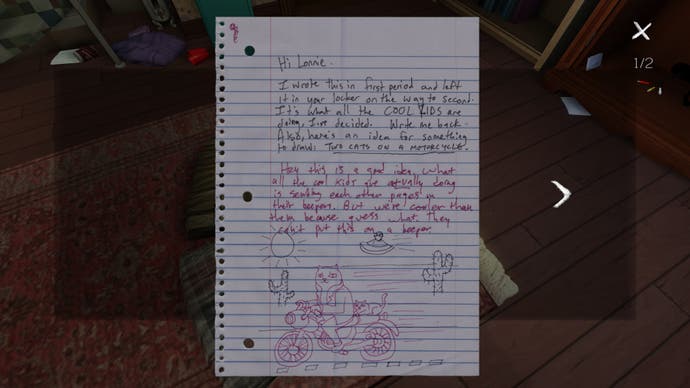
Gone Home struggles, however, when it comes to connecting these inner lives to each other. Family squabbles acted out in months' worth of scribbled post-its, still stuck to the walls, feel forced and unconvincing. Mum and Dad are credible and interesting characters - she's a forestry conservationist struggling with her distant husband, he's a frustrated sci-fi writer bashing out reviews of Laserdisc players for an unappreciative AV magazine - but just as they start to coalesce, they're gone again, dissipating inconclusively like mist as the game builds towards its conclusion.
You can't escape the sense that The Fullbright Company started on this project with grand designs for games as a storytelling medium, yet without a story they desperately wanted to tell
In the end, this is Sam's story, something made clear by the unfair advantage she's given: a voice. On discovering certain key clues, you'll hear Sam reading a journal she's been keeping which is addressed to Katie, but which, oddly, you haven't found yet. (This is something of a narrative non-sequitur, but let's call the foreknowledge it gives you a necessary evil in driving the story forward, and move on.) It's a classic coming of age tale; a simple portrait of Sam's growing pains that's sometimes touching, and certainly enlivened by the sharply observed period detail, but that would come across as deeply generic if it wasn't told in such an unconventional medium. It could so easily have been ripped from the teen TV soaps of the time - Dawson's Creek or My So Called Life, say - yet it doesn't muster the quirk or wit or courage of those shows at their best. Without those qualities, without the ability to bring its characters together - and despite Sam's strong, if disembodied presence - Gone Home verges on the trite.
As a statement of intent, Gone Home is laudable; as a technical exercise in game narrative, it's compromised, but it definitely has its strengths and is worthy of study. But you can't escape the sense that Gaynor, Zimonja and Nordhagen started on this project with grand designs for games as a storytelling medium, yet without a story they desperately wanted to tell.
"A house is not a home," as the old song goes. Gone Home's mansion is half-inhabited, the family's possessions still stacked in boxes after the move. The game itself feels similar. The Fullbright Company has built a fine house for intimate storytelling in games, but it hasn't found the story to live in it yet.




